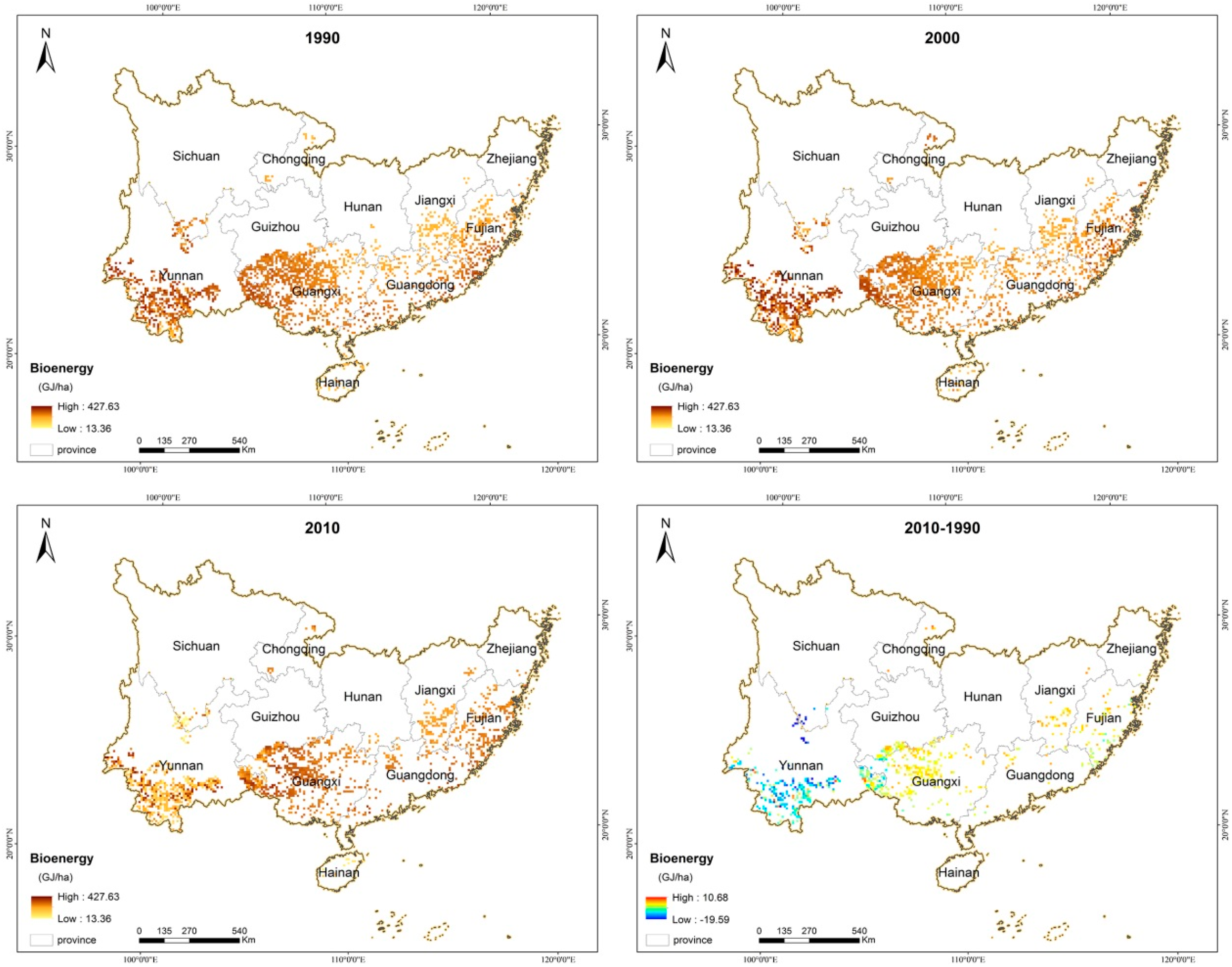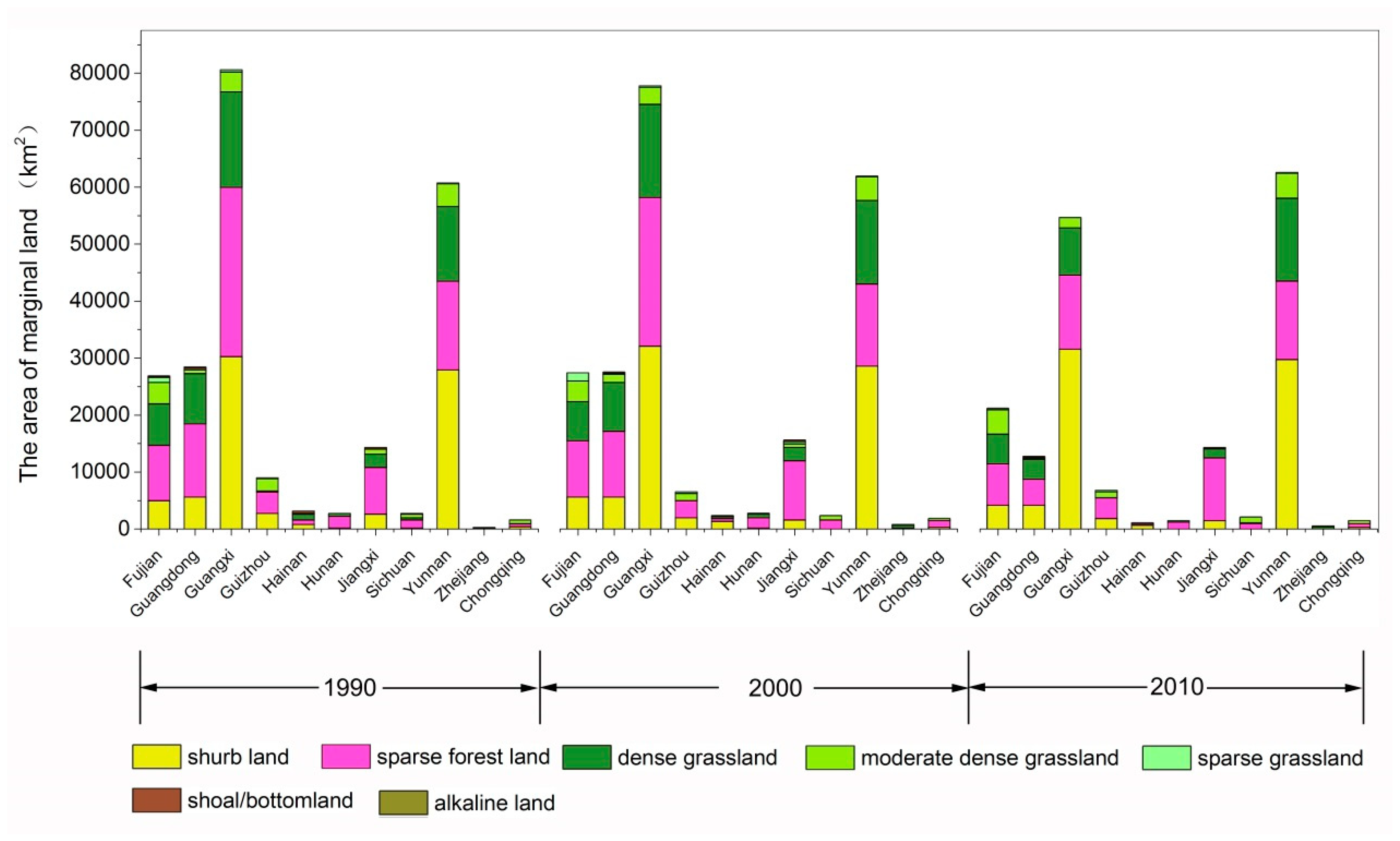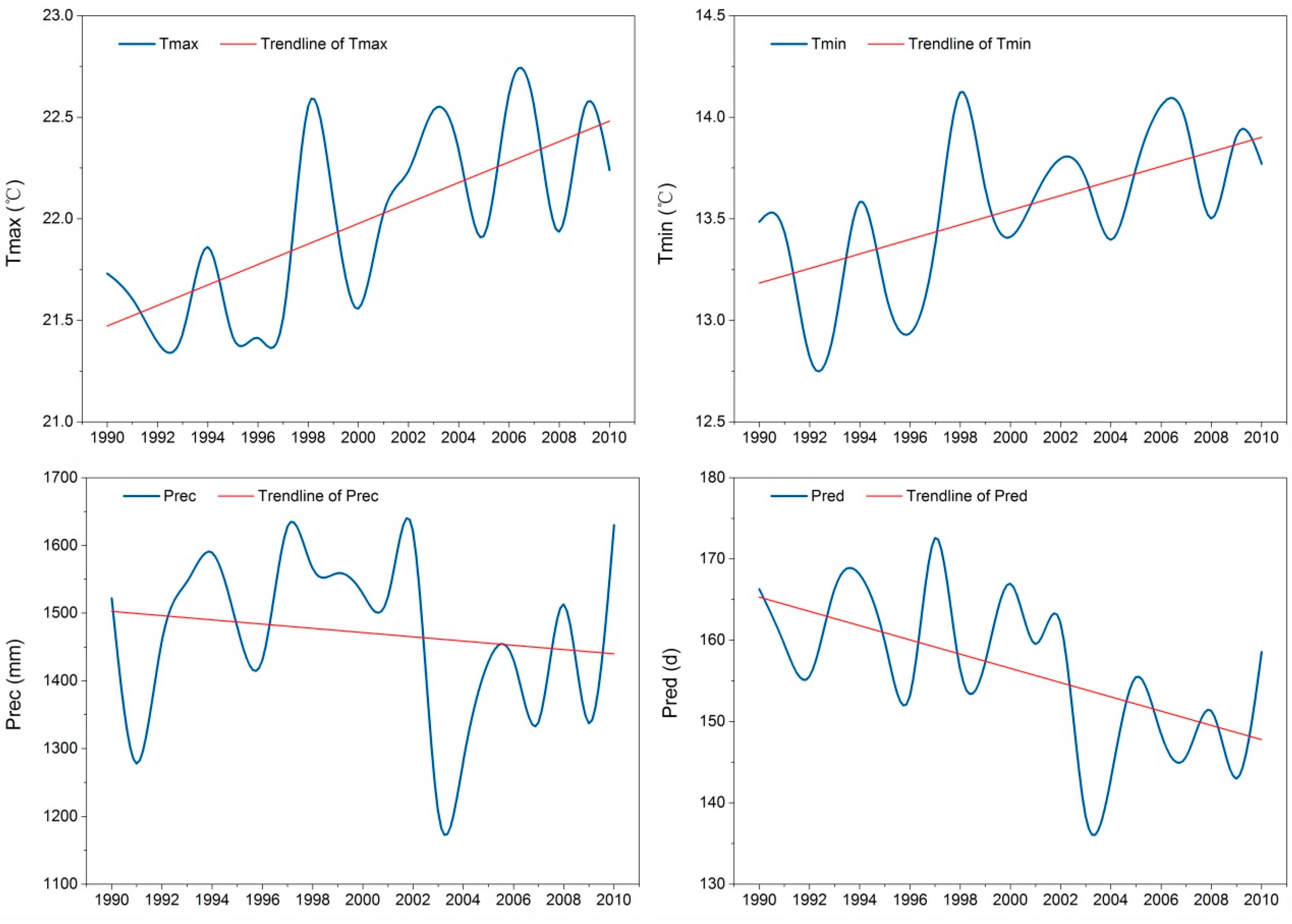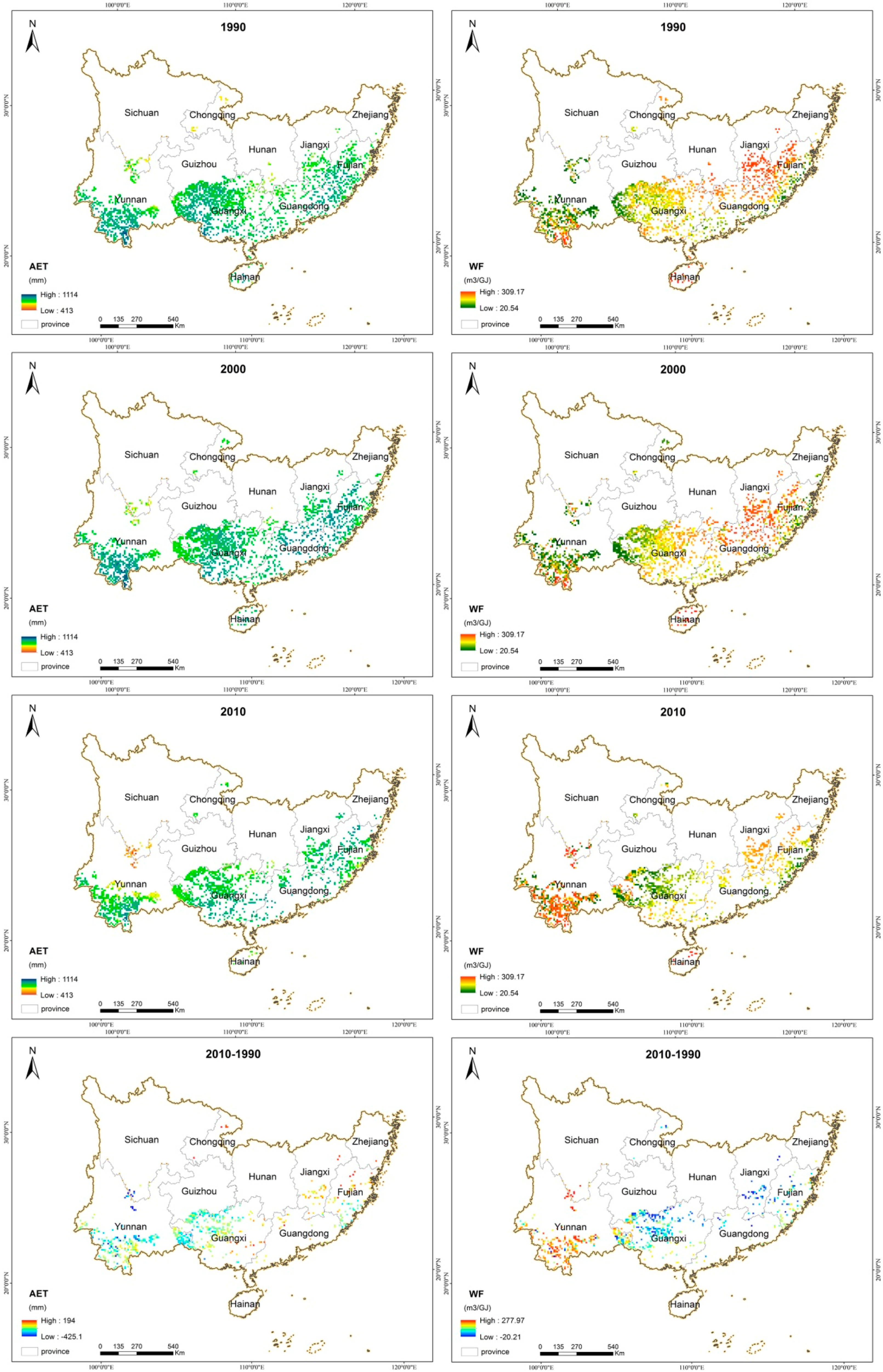Assessing the Sustainable Development of Bioenergy from Cassava within “Water-Energy-Food” Nexus Framework in China
Abstract
1. Introduction
2. Materials and Methods
2.1. Land Resources Suitable for Cassava
2.2. Long-Term Climate Data Sequence
2.3. Biogeochemical Process Model
2.4. Calculation of Bioenergy and Water Footprint
3. Results
3.1. Spatial-Temporal Variation in Potential Bioenergy from Cassava
3.2. Analysis of the Driving Forces of Bioenergy Change
3.2.1. Impact of Landuse Change on Bioenergy Produced from Cassava
3.2.2. Impact of Climate Change on Bioenergy Produced from Cassava
3.3. Spatial-Temporal Variation in Water Footprint of Bioenergy from Cassava
4. Discussion
5. Conclusions
Supplementary Materials
Author Contributions
Acknowledgments
Conflicts of Interest
References
- Souza, G.M.; Ballester, M.V.R.; Cruz, C.H.D.B.; Chum, H.; Dale, B.; Dale, V.H.; Fernandes, E.C.M.; Foust, T.; Karp, A.; Lynd, L. The role of bioenergy in a climate-changing world. Environ. Dev. 2017, 23, 57–64. [Google Scholar] [CrossRef]
- Renewable Energy Policy Network for the 21st Century (REN21). Available online: http://www.Ren21.Net/status-of-renewables/global-status-report/ (accessed on 8 May 2018).
- Masera, O.R.; Bailis, R.; Drigo, R.; Ghilardi, A.; Ruiz-Mercado, I. Environmental Burden of Traditional Bioenergy Use. Annu. Rev. Environ. Resour. 2015, 40, 121–150. [Google Scholar] [CrossRef]
- Zhou, A.; Thomson, E. The development of biofuels in Asia. Appl. Energy 2009, 86, S11–S20. [Google Scholar] [CrossRef]
- Sahoo, P.K.; Das, L.M.; Babu, M.K.G.; Naik, S.N. Biodiesel development from high acid value polanga seed oil and performance evaluation in a CI engine. Fuel 2007, 86, 448–454. [Google Scholar] [CrossRef]
- Ahrens, T.; Drescherhartung, S.; Anne, O. Sustainability of future bioenergy production. Waste Manag. 2017, 67, 1–2. [Google Scholar] [CrossRef] [PubMed]
- Garcia, D.J.; You, F. The water-energy-food nexus and process systems engineering: A new focus. Comput. Chem. Eng. 2016, 91, 49–67. [Google Scholar] [CrossRef]
- Giupponi, C.; Gain, A.K. Integrated spatial assessment of the water, energy and food dimensions of the sustainable development goals. Reg. Environ. Chang. 2017, 17, 1881–1893. [Google Scholar] [CrossRef]
- Zhang, X.; Vesselinov, V.V. Integrated modeling approach for optimal management of water, energy and food security nexus. Adv. Water Resour. 2017, 101, 1–10. [Google Scholar] [CrossRef]
- López-Díaz, D.C.; Lira-Barragán, L.F.; Rubio-Castro, E.; Serna-González, M.; El-Halwagi, M.M.; Ponce-Ortega, J.M. Optimization of biofuels production via a water–energy–food nexus framework. Clean Technol. Environ. Policy 2017, 1–24. [Google Scholar] [CrossRef]
- Mirzabaev, A.; Guta, D.; Goedecke, J.; Gaur, V.; Börner, J.; Virchow, D.; Denich, M.; Braun, J.V. Bioenergy, food security and poverty reduction: Trade-offs and synergies along the water-energy-food security nexus. Soc. Sci. Electron. Publ. 2015, 40, 772–790. [Google Scholar] [CrossRef]
- BP. Available online: https://www.Bp.Com/ (accessed on 8 May 2018).
- Gosens, J.; Kåberger, T.; Wang, Y. China’s next renewable energy revolution: Goals and mechanisms in the 13th five year plan for energy. Energy Sci. Eng. 2017, 5, 141–155. [Google Scholar] [CrossRef]
- National Development and Reform Commission (NDRC) People’s Republic of China. Available online: http://en.Ndrc.Gov.Cn/ (accessed on 8 May 2018).
- Jiang, D.; Hao, M.M.; Fu, J.Y.; Huang, Y.H.; Liu, K.; Zhou, Y.; Kumar, L.; Mabee, W. Evaluating the bioenergy potential of cassava on marginal land using a biogeochemical process model in guangxi, china. J. Appl. Remote Sens. 2015, 9, 097699. [Google Scholar] [CrossRef]
- Zvinavashe, E.; Elbersen, H.W.; Slingerland, M.; Kolijn, S.; Sanders, J.P.M. Cassava for food and energy: Exploring potential benefits of processing of cassava into cassava flour and bioenergy at farmstead and community levels in rural mozambique. Biofuels Bioprod. Biorefin. 2015, 5, 151–164. [Google Scholar] [CrossRef]
- Ozoegwu, C.G.; Eze, C.; Onwosi, C.O.; Mgbemene, C.A.; Ozor, P.A. Biomass and bioenergy potential of cassava waste in nigeria: Estimations based partly on rural-level garri processing case studies. Renew. Sustain. Energy Rev. 2017, 72, 625–638. [Google Scholar] [CrossRef]
- Wang, F.; Zhuo, L.; Qin, X.D.; Li, S.Y.; Yang, Z.H.; Huang, H.J. Evaluation on suitability of planting potential of energy plants on marginal land of guangdong province. Trans. Chin. Soc. Agric. Eng. 2015, 31, 276–284. [Google Scholar]
- Chandra, V.V.; Hemstock, S.L. The potential of sugarcane bioenergy in fiji. Sugar Tech 2016, 18, 229–235. [Google Scholar] [CrossRef]
- Ziska, L.H.; Runion, G.B.; Tomecek, M.; Prior, S.A.; Torbet, H.A.; Sicher, R. An evaluation of cassava, sweet potato and field corn as potential carbohydrate sources for bioethanol production in alabama and maryland. Biomass Bioenergy 2009, 33, 1503–1508. [Google Scholar] [CrossRef]
- Wu, M.; Wang, M.; Hong, H. Fuel-Cycle Assessment of Selected Bioethanol Production; Argonne National Laboratory (ANL): Lemont, IL, USA, 2007. [Google Scholar]
- Le, L.T.; van Ierland, E.C.; Zhu, X.; Wesseler, J. Energy and greenhouse gas balances of cassava-based ethanol. Biomass Bioenergy 2013, 51, 125–135. [Google Scholar] [CrossRef]
- Jiang, D.; Hao, M.; Fu, J.; Tian, G.; Ding, F. Estimating the potential of energy saving and carbon emission mitigation of cassava-based fuel ethanol using life cycle assessment coupled with a biogeochemical process model. Int. J. Biometeorol. 2017. [Google Scholar] [CrossRef] [PubMed]
- Kurian, M. The water-energy-food nexus. Environ. Sci. Policy 2017, 68, 97–106. [Google Scholar] [CrossRef]
- Hao, M.; Jiang, D.; Wang, J.; Fu, J.; Huang, Y. Could biofuel development stress China’s water resources? GCB Bioenergy 2017, 9, 1447–1460. [Google Scholar] [CrossRef]
- Yan, X.; Jiang, D.; Fu, J.; Hao, M. Assessment of Sweet Sorghum-Based Ethanol Potential in China within the Water–Energy–Food Nexus Framework. Sustainability 2018, 10, 1046. [Google Scholar] [CrossRef]
- Fu, J.; Dong, J.; Huang, Y.; Zhuang, D.; Wei, J. Evaluating the marginal land resources suitable for developing bioenergy in asia. Adv. Meteorol. 2014, 2014, 45–49. [Google Scholar] [CrossRef]
- Zhuang, D.; Jiang, D.; Liu, L.; Huang, Y. Assessment of bioenergy potential on marginal land in china. Renew. Sustain. Energy Rev. 2011, 15, 1050–1056. [Google Scholar] [CrossRef]
- Dong, J.; Hao, M.; Fu, J.; Zhuang, D.; Huang, Y. Spatial-temporal variation of marginal land suitable for energy plants from 1990 to 2010 in china. Sci. Rep. 2014, 4, 5816. [Google Scholar]
- Tan, J.; Li, A.; Lei, G. Contrast on anusplin and cokriging meteorological spatial interpolation in southeastern margin of Qinghai-Xizang plateau. Plateau Meteorol. 2016, 35, 875–886. [Google Scholar]
- The, C.; Hutchinson, M.; Johnson, F.; Beesley, C.; Green, J. Application of Anusplin to Produce New Intensity-Frequency-Duration (IFD) Index Rainfalls across Australia; Engineers Australia: Barton, Australia, 2014. [Google Scholar]
- Bernardos, J.N.; Viglizzo, E.F.; Jouvet, V.; Lértora, F.A.; Pordomingo, A.J.; Cid, F.D. The use of epic model to study the agroecological change during 93 years of farming transformation in the argentine pampas. Agric. Syst. 2001, 69, 215–234. [Google Scholar] [CrossRef]
- Liu, J.; Williams, J.R.; Zehnder, A.J.B.; Yang, H. Gepic—Modelling wheat yield and crop water productivity with high resolution on a global scale. Agric. Syst. 2007, 94, 478–493. [Google Scholar] [CrossRef]
- Liu, J. A gis-based tool for modelling large-scale crop-water relations. Environ. Model. Softw. 2009, 24, 411–422. [Google Scholar] [CrossRef]
- Liu, J.G. Consumptive water use in cropland and its partitioning: A high-resolution assessment. Sci. China 2009, 52, 3309–3314. [Google Scholar] [CrossRef]
- Liu, J.; Hong, Y.; Zehnder, A.J.B. Drops for crops: Modelling crop water productivity on a global scale. Glob. Nest J. 2007, 10, 295–300. [Google Scholar]
- Rahman, S.; Awerije, B.O. Technical and scale efficiency of cassava production system in delta state, nigeria: An application of two-stage dea approach. J. Agric. Rural Dev. Trop. Subtrop. 2015, 116, 59–69. [Google Scholar]
- Jongschaap, R.E.; Blesgraaf, R.A.; Bogaard, T.A.; van Loo, E.N.; Savenije, H.H. The water footprint of bioenergy from Jatropha curcas L. Proc. Natl. Acad. Sci. USA 2009, 106, E92. [Google Scholar] [CrossRef] [PubMed]
- Mathioudakis, V.; Gerbens-Leenes, P.W.; Meer, T.H.V.D.; Hoekstra, A.Y. The water footprint of second-generation bioenergy: A comparison of biomass feedstocks and conversion techniques. J. Clean. Prod. 2017, 148, 571–582. [Google Scholar] [CrossRef]
- Gerbensleenes, W.; Hoekstra, A.Y.; Th, V.D.M. The water footprint of bioenergy. Proc. Natl. Acad. Sci. USA 2009, 106, 10219. [Google Scholar] [CrossRef] [PubMed]
- Seabra, J.; Hernandes, T.; Galdos, M. Water Footprint and Water Consumption for the Main Crops and Biofuels Produced in Brazil. Available online: http://adsabs.harvard.edu/abs/2011AGUFM.H11M..05S (accessed on 19 June 2018).
- Hernandes, T.A.D.; Bufon, V.B.; Seabra, J.E.A. Water footprint of biofuels in Brazil: Assessing regional differences. Biofuels Bioprod. Biorefin. 2014, 8, 241–252. [Google Scholar] [CrossRef]
- Chen, B.; Hao, S.; Yang, X. The Dynamic Mechanism of the Rapid Development of Urbanization in China. Acta Geogr. Sin. 2004, 59, 1068–1075. [Google Scholar]
- China Statistical Yearbook. Available online: http://www.stats.gov.cn/ (accessed on 19 June 2018).
- Höffle, H.; Wernberg, T.; Thomsen, M.S.; Holmer, M. Drift algae, an invasive snail and elevated temperature reduce ecological performance of a warm-temperate seagrass, through additive effects. Mar. Ecol. Prog. 2012, 450, 67–80. [Google Scholar] [CrossRef]
- Wang, X.; Cai, J.; Liu, F.; Jin, M.; Yu, H.; Dong, J.; Wollenweber, B.; Dai, T.; Cao, W. Pre-anthesis high temperature acclimation alleviates the negative effects of post-anthesis heat stress on stem stored carbohydrates remobilization and grain starch accumulation in wheat. J. Cereal Sci. 2012, 55, 331–336. [Google Scholar] [CrossRef]
- Millar, R.; Fuglestvedt, J.S.; Grubb, M.; Rogelj, J.; Skeie, R.B.; Friedlingstein, P.; Forster, P.; Frame, D.J.; Pierrehumbert, R.; Allen, M.R. Future Emissions Pathways Consistent with Limiting Warming to 1.5 °C. Available online: http://adsabs.harvard.edu/abs/2016AGUFMGC24D..04M (accessed on 19 June 2018).
- Torjesen, I. Paris agreement’s ambition to limit global warming to 1.5 °C still possible, analysis shows. BMJ 2017, 358. [Google Scholar] [CrossRef] [PubMed]






| Province | Bioenergy Production (GJ/ha) | Bioenergy Production (PJ) | ||||
|---|---|---|---|---|---|---|
| 1990 | 2000 | 2010 | 1990 | 2000 | 2010 | |
| Fujian | 246 | 256 | 267 | 667 | 677 | 595 |
| Guangdong | 257 | 247 | 275 | 700 | 627 | 323 |
| Guangxi | 269 | 262 | 284 | 2090 | 2039 | 1508 |
| Guizhou | 269 | 272 | 269 | 281 | 196 | 197 |
| Hainan | 176 | 180 | 86 | 57 | 46 | 11 |
| Hunan | 189 | 205 | 226 | 44 | 69 | 29 |
| Jiangxi | 189 | 207 | 232 | 248 | 307 | 326 |
| Sichuan | 269 | 241 | 120 | 97 | 56 | 28 |
| Yunnan | 302 | 314 | 215 | 1847 | 1882 | 1328 |
| Zhejiang | 227 | 292 | 267 | 6 | 26 | 14 |
| Chongqing | 194 | 272 | 258 | 38 | 49 | 40 |
| Average/Sum | 235 | 250 | 227 | 6075 | 5974 | 4399 |
| Climatic Index | 1990 | 1991 | 1992 | 1993 | 1994 | 1995 | 1996 |
| Tmax (°C) | 21.73 | 21.61 | 21.39 | 21.43 | 21.86 | 21.42 | 21.41 |
| Tmin (°C) | 13.48 | 13.43 | 12.82 | 12.96 | 13.58 | 13.15 | 12.94 |
| Prec (mm) | 1522.00 | 1277.65 | 1459.23 | 1546.59 | 1589.17 | 1479.77 | 1431.35 |
| Pred (d) | 166 | 159 | 156 | 166 | 168 | 160 | 153 |
| Climatic Index | 1997 | 1998 | 1999 | 2000 | 2001 | 2002 | 2003 |
| Tmax (°C) | 21.51 | 22.56 | 22.09 | 21.56 | 22.03 | 22.24 | 22.54 |
| Tmin (°C) | 13.37 | 14.12 | 13.65 | 13.41 | 13.62 | 13.80 | 13.70 |
| Prec (mm) | 1627.82 | 1566.25 | 1558.93 | 1528.39 | 1524.34 | 1619.41 | 1206.26 |
| Pred (d) | 173 | 156 | 157 | 167 | 160 | 162 | 138 |
| Climatic Index | 2004 | 2005 | 2006 | 2007 | 2008 | 2009 | 2010 |
| Tmax (°C) | 22.34 | 21.92 | 22.61 | 22.55 | 21.94 | 22.55 | 22.24 |
| Tmin (°C) | 13.40 | 13.75 | 14.06 | 13.97 | 13.50 | 13.91 | 13.77 |
| Prec (mm) | 1280.82 | 1428.26 | 1430.68 | 1339.28 | 1512.60 | 1337.25 | 1630.00 |
| Pred (d) | 143 | 155 | 148 | 146 | 151 | 143 | 159 |
| Province | Water Footprint of Bioenergy from Cassava (m3/GJ) | ||
|---|---|---|---|
| 1990 | 2000 | 2010 | |
| Fujian | 36.14 | 36.87 | 32.84 |
| Guangdong | 34.25 | 37.97 | 32.79 |
| Guangxi | 33.12 | 34.63 | 30.83 |
| Guizhou | 32.81 | 32.81 | 31.68 |
| Hainan | 53.82 | 58.10 | 104.55 |
| Hunan | 40.53 | 40.00 | 34.10 |
| Jiangxi | 44.16 | 43.59 | 37.70 |
| Sichuan | 28.10 | 33.25 | 114.48 |
| Yunnan | 31.16 | 30.17 | 47.20 |
| Zhejiang | 33.82 | 28.78 | 32.97 |
| Chongqing | 35.13 | 29.35 | 31.44 |
| Average | 36.64 | 36.86 | 48.23 |
© 2018 by the authors. Licensee MDPI, Basel, Switzerland. This article is an open access article distributed under the terms and conditions of the Creative Commons Attribution (CC BY) license (http://creativecommons.org/licenses/by/4.0/).
Share and Cite
Jiang, D.; Chen, S.; Hao, M.; Fu, J.; Ding, F. Assessing the Sustainable Development of Bioenergy from Cassava within “Water-Energy-Food” Nexus Framework in China. Sustainability 2018, 10, 2153. https://doi.org/10.3390/su10072153
Jiang D, Chen S, Hao M, Fu J, Ding F. Assessing the Sustainable Development of Bioenergy from Cassava within “Water-Energy-Food” Nexus Framework in China. Sustainability. 2018; 10(7):2153. https://doi.org/10.3390/su10072153
Chicago/Turabian StyleJiang, Dong, Shuai Chen, Mengmeng Hao, Jingying Fu, and Fangyu Ding. 2018. "Assessing the Sustainable Development of Bioenergy from Cassava within “Water-Energy-Food” Nexus Framework in China" Sustainability 10, no. 7: 2153. https://doi.org/10.3390/su10072153
APA StyleJiang, D., Chen, S., Hao, M., Fu, J., & Ding, F. (2018). Assessing the Sustainable Development of Bioenergy from Cassava within “Water-Energy-Food” Nexus Framework in China. Sustainability, 10(7), 2153. https://doi.org/10.3390/su10072153







